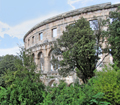A lot of beautiful buildings -- Greek
and Roman and Byzantine for a start -- and whole mountain
ranges of pristine forest. That's what I had heard about the
west Balkans. That, and a lot of war scars.
Pictures of forest, especially when you can't stop the bus exactly where you want, are hard to come by. And the war scars? You can feel it in the old men and women, especially in Bosnia, and you can see it in the houses left shattered in Mostar and, subtly, in the mixed old and new roof tiles in Dubrovnik.
For the most part, though, the photographs in this show are about the use and orientation of stone -- and, although you can only see it close up and occasionally (most notably in orthodox church, apollonia), the reuse of stone.
Most photogenic of the walled cities is Dubrovnik. The main streets are wide, the plazas are large, and the city was wealthy for 500 years and built great palaces, bell towers, churches, and sculptures. Most of all, they built monumental walls, with pathways on top of the walls all the way around (see city wall, dubrovnik), and the town lying sometimes below and sometimes arms-length away. Although they likely didn't build the walls for photographers, they did build for line of sight: for defenders but also, because the architects were often artists, for inner and outer views. For me, the vision of the Adriatic and the islands, over the battlements or through the city, is the most inspiring sight of all.
Pictures of forest, especially when you can't stop the bus exactly where you want, are hard to come by. And the war scars? You can feel it in the old men and women, especially in Bosnia, and you can see it in the houses left shattered in Mostar and, subtly, in the mixed old and new roof tiles in Dubrovnik.
For the most part, though, the photographs in this show are about the use and orientation of stone -- and, although you can only see it close up and occasionally (most notably in orthodox church, apollonia), the reuse of stone.
Most photogenic of the walled cities is Dubrovnik. The main streets are wide, the plazas are large, and the city was wealthy for 500 years and built great palaces, bell towers, churches, and sculptures. Most of all, they built monumental walls, with pathways on top of the walls all the way around (see city wall, dubrovnik), and the town lying sometimes below and sometimes arms-length away. Although they likely didn't build the walls for photographers, they did build for line of sight: for defenders but also, because the architects were often artists, for inner and outer views. For me, the vision of the Adriatic and the islands, over the battlements or through the city, is the most inspiring sight of all.

